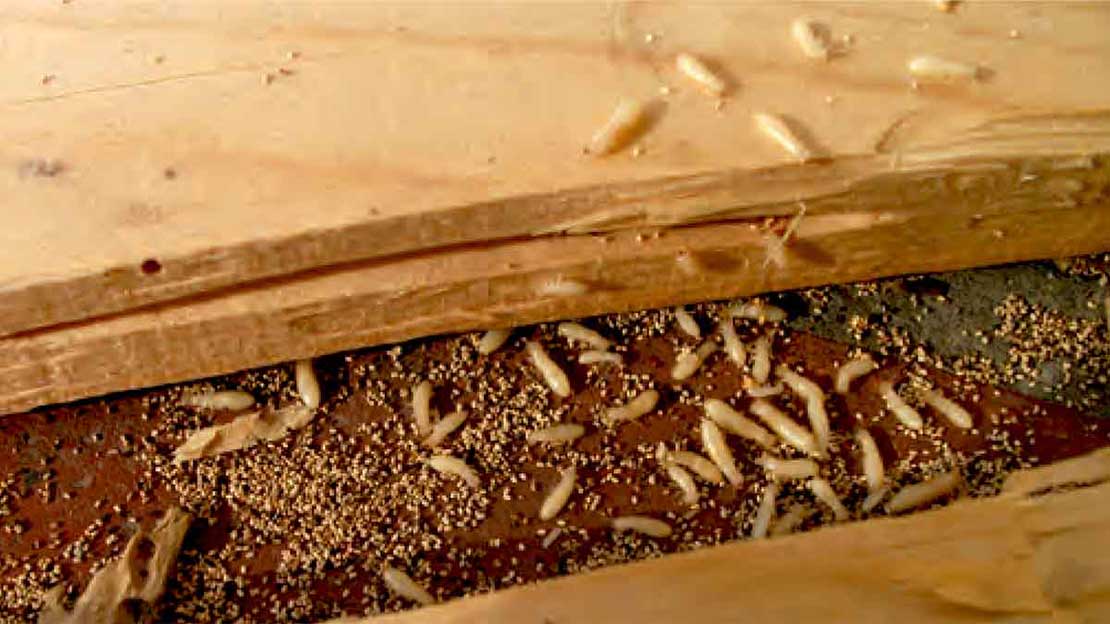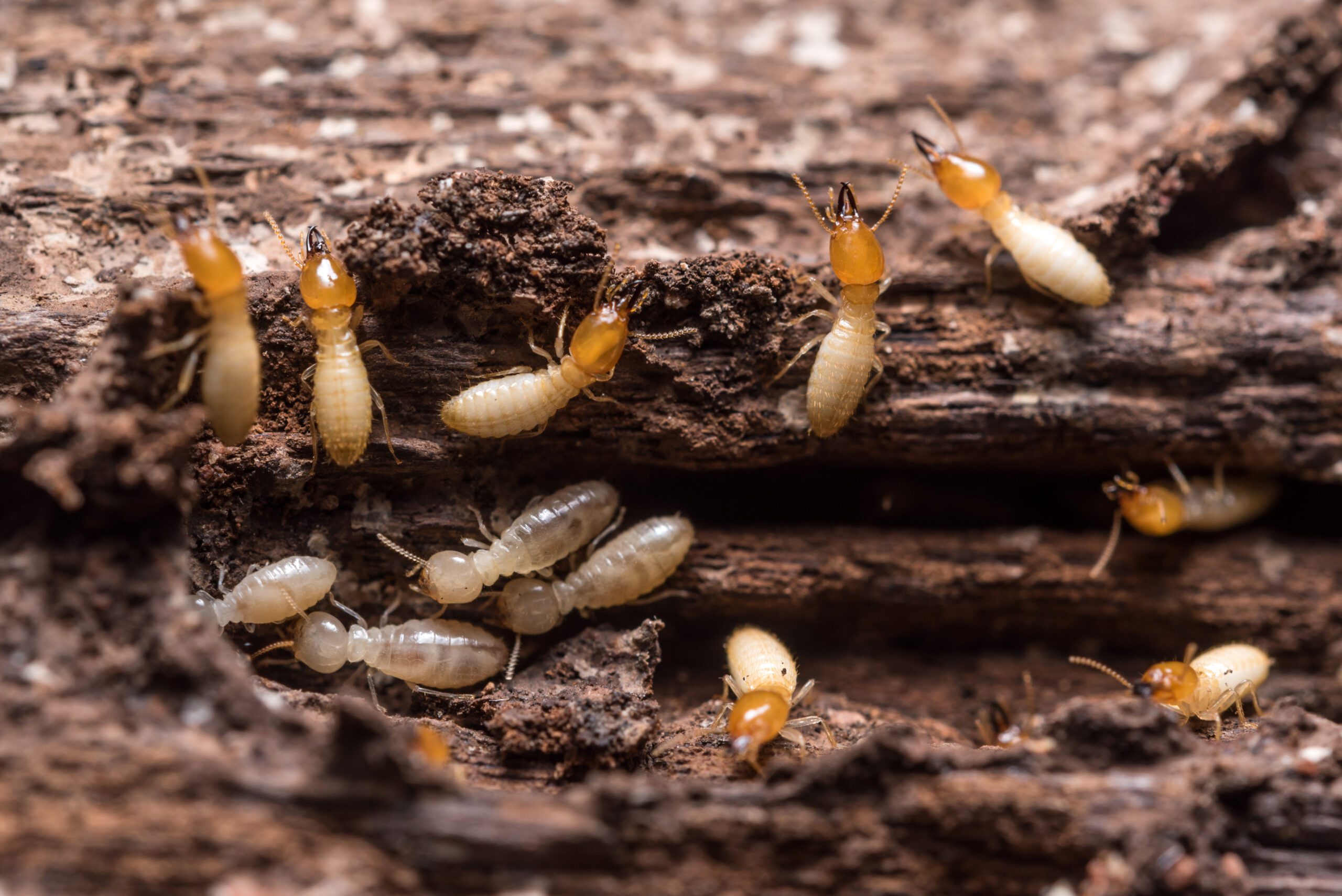Termite Treatments in Florida
Exterminator Services for Clearwater, Clearwater Beach, Largo, and Belleair Beach
Florida’s subtropical climate, prized for its mild winters and steady warmth, also creates near-ideal conditions for termites. These wood-boring insects routinely infiltrate buildings in search of cellulose, the primary component of wood, which they consume to sustain their colonies. In Clearwater, Clearwater Beach, Largo, and Belleair Beach, overlooking subtle termite activity can eventually cost property owners extensive structural damage and repair bills. The harm termites cause often remains invisible until severe weakening or cosmetic harm emerges. This service page explains why termites thrive in Florida’s environment, the main signs that an infestation may be underway, and why enlisting a professional termite exterminator for termite treatments is your best move to preserve a sturdy, worry-free living or working environment. By addressing the problem at its earliest hints, you avoid spreading colonies, mounting repair costs, and the frustration of dealing with unseen invaders quietly feasting on your wooden supports.
Why Termites Flourish in Florida
- Mild, Subtropical Temperatures
Termites remain sensitive to extreme cold, which can disrupt their breeding cycles in northern climates for months. Florida’s mild winter rarely sustains subfreezing conditions, enabling termite colonies to remain active and reproduce nearly throughout the year. Even brief cold snaps do little to hamper indoor termite activity if the interior is heated or air-conditioned. - High Humidity and Frequent Rain
Many termite species, particularly subterranean types, depend on moisture for survival. Florida’s regular rainfall and naturally high humidity ensure damp soil, which subterranean termites use to build protective mud tubes. Dampwood termites favor rotting or moist wood near leaks or poorly ventilated corners. These conditions help colonies grow faster in southwestern Florida than in cooler, drier areas. - Extended Breeding Cycles
In many northern states, termites enter dormancy during freezing winters, pausing reproduction for several months. In Florida, no such freeze deters them. Without forced downtime, a small termite population can quickly escalate into a major infestation if no occupant notices telltale signs and obtains quick solutions. - Construction and Development
Ongoing building in areas like Clearwater or Largo disrupts termite habitats, pushing them to move or find new wooden structures. Older properties with cracks in foundations or direct soil-to-wood contact also lure termites seeking accessible cellulose. Once they find an entry point, they keep tunneling until discovered. - Frequent Occupant Movement
Many regions in Florida, including Clearwater Beach or Belleair Beach, attract tourists, seasonal residents, or short-term rentals. Termites occasionally hitch rides in wooden crates or secondhand furniture, moving from one locale to another. If the property’s existing conditions remain suitable—damp corners, untreated wood—termites establish nests swiftly.

Signs of a Termite Infestation
- Discarded Wings
Reproductive termites (often called swarmers) emerge from established colonies to start new ones. After landing, they shed their wings. Discovering small piles of identical, translucent wings near window sills, door frames, or light fixtures signals active termite swarms in or around your property. - Mud Tubes
Subterranean termites build thin, earthen tunnels along foundations, basement walls, or crawl spaces, preserving moisture while traveling from soil to wood. Spotting these pencil-thin tubes strongly indicates ongoing termite exploration. Breaking a section of these tubes might reveal live termites scurrying inside if they are active. - Frass (Droppings)
Drywood termites produce small, pellet-like droppings known as frass. These six-sided pellets gather under infested wood—like window frames, door jambs, or furniture. If you see tidy piles resembling sawdust or sand grains, it likely confirms drywood termite presence. - Hollow or Damaged Wood
Tapping walls or floorboards that sound hollow or cause minor collapse under slight pressure suggests internal tunneling by termites. Termites typically consume wood from the inside out, leaving a thin external surface that may eventually crack or buckle. - Swarmer Sightings
Winged termites often appear in warmer months or after rain, clustering around lights. Spotting swarmers indoors signals an established colony. Acting immediately helps block them from forming new nests across multiple rooms or expansions throughout structural wood.
Risks of Ignoring Termites
- Structural Degradation
Over time, termites can undermine wooden beams, joists, or supports, jeopardizing structural integrity. Floors might sag, walls could crack, or entire sections of framing may require replacement once extensive damage is revealed. Early intervention prevents more severe outcomes. - High Repair Costs
The longer termites remain undiscovered, the deeper they tunnel and the more advanced the repairs needed. Replacing rotted wood, reinforcing beams, or redoing entire sections of a building can be expensive, especially if multiple stories or expansions suffer infestation. - Continual Anxiety
Knowing that insects feast behind walls fosters occupant stress. Families may avoid certain rooms or worry about potential hazards from compromised supports. Professional elimination spares owners ongoing tension about unseen structural breakdowns.
Reduced Property Value
Real estate transactions often require termite inspections, which can halt or complicate sales if an infestation is active or left unresolved. Lenders and buyers expect a clear termite report, so ignoring the problem can derail closings or force expensive last-minute remedies.

Why Professional Termite Treatments Work Best
- In-Depth Inspection
A qualified termite exterminator studies your property, checking foundations, attics, crawl spaces, or baseboards. By pinpointing mud tubes, droppings, and compromised wood, they ascertain whether subterranean or drywood termites lurk, shaping the correct treatment approach. - Targeted Colony Destruction
Exterminators pick suitable methods—like soil barriers, bait systems, or fumigation—depending on termite species and infestation extent. Subterranean termites might require perimeter trenching with termiticides or installing bait stations. Drywood termites might need fumigation or localized injections in limited areas. - Preventing Renewed Access
Specialists not only remove existing colonies but also show occupants how to block re-entry. This can involve sealing foundation cracks, ensuring no direct soil-to-wood contact, and addressing moisture sources (leaks, drainage, or ventilation). Cutting off termites from wood or dampness deters further invasions. - Egg or Hidden Colony Coverage
Because termite queens can continuously lay eggs, partial treatments seldom suffice if an out-of-reach portion of the nest remains. Professionals confirm coverage extends to all possible nest zones—like behind walls or under floors—while occupant checks or scheduling re-inspections catch any survivors. - Safety and Precision
Rather than flooding large areas with chemicals, professionals place termiticides carefully, protecting occupant health while ensuring termites contact lethal doses. Occupants may have to vacate briefly if fumigation proves necessary for comprehensive coverage.
Effective Methods Used in Termite Treatments
- Soil Treatment and Trenching
For subterranean termites, digging shallow trenches around a structure’s perimeter and filling them with termiticide creates a barrier. Any termites crossing this barrier die. Technicians might also drill small holes near slabs or patios, injecting termiticide into the soil below. - Bait Stations
Bait systems containing slow-acting toxins tempt worker termites. Upon ingestion, workers carry toxins back to the colony, eliminating it gradually. Periodic station checks measure activity levels and verify colony collapse. Baits often prove especially useful in environment-sensitive areas. - Drywood Termite Solutions
Drywood termites within limited areas may be tackled via localized spot treatments—like injecting termiticides directly into infested beams or using foam expansions. If multiple rooms or large wooden structures are heavily compromised, whole-building fumigation saturates the area with a lethal gas, eradicating hidden colonies at every life stage. - Moisture Remediation
Repairs addressing leaks or improving ventilation hamper termite re-entry. Damp soils or rotted wood near foundations entice termites. By restoring dryness—fixing roof leaks or drip lines—occupants reduce re-infestation odds. Many exterminators highlight moisture management as integral to termite prevention. - Follow-Up Inspections
After removing a colony, scheduling yearly or twice-yearly termite checks ensures no new swarms emerge. Early detection of stray swarmers or fresh mud tubes spares owners from repeated extensive damage, letting small issues be dealt with promptly.
Locations We Serve: Clearwater, Clearwater Beach, Largo, and Belleair Beach
Clearwater: A dynamic coastal city blending older houses, renovated condos, and commercial developments. Termites exploit foundation gaps or wooden structures if dampness remains. Regular property reviews plus occupant diligence hamper infiltration.
Clearwater Beach: Draws tourists and short-term rentals year-round, magnifying occupant turnover. If no occupant notices early signs, termite colonies can spread behind walls. Thorough building-wide solutions ensure minimal occupant disruption while safeguarding property value.
Largo: A suburban area with new expansions and older neighborhoods. Termites can nest in rotted deck supports, direct soil-wood contact points, or behind older drywall. Collaborative occupant efforts—like removing yard debris or addressing humidity—combined with professional perimeter barriers maintain a termite-free environment.
Belleair Beach: Known for a quieter coastal vibe, Belleair Beach sees both seasonal dwellers and permanent residents. Unoccupied homes or unmonitored yard corners give termites the chance to thrive unchallenged. Routine checks or occupant collaboration hamper hidden nest formations.

Why Our Termite Treatments Excel
- Florida-Focused Solutions
Because southwestern Florida’s climate rarely halts termite breeding, we integrate occupant checks, soil treatments, or targeted fumigation to strike colonies at every level. Subterranean or drywood infestations meet customized approaches suiting local conditions. - Precision and Safety
Our exterminator team places chemical treatments exactly where termites travel—like sub-slab injections or direct nest injections—limiting occupant exposure. This approach spares large-scale pesticide usage in favor of precise hits to termite highways or nests. - Integrated Moisture Management
By advising on roof leak fixes, ventilation improvements, or yard drainage, we cut off termites from the moisture that fosters them. Removing or repairing rotten wood also denies them easy meals. This synergy of occupant action plus professional treatments ensures stable results. - Ongoing Assurance
Because termite queens can keep laying eggs, re-checks or occupant-based vigilance matters. If occupant sightings of swarmers or fresh mud tubes reappear, we revisit swiftly, adjusting solutions before significant structural damage recurs.
Call to Action
Have you spotted mud tubes near your foundation, noticed small droppings under windows, or discovered hollow-sounding wood? Contact us to learn more or schedule your service. Our termite treatments in Clearwater, Clearwater Beach, Largo, and Belleair Beach target hidden colonies—covering eggs, nymphs, and adult termites—to safeguard your property’s wooden supports. By partnering with an experienced termite exterminator, you take proactive steps to prevent further infiltration, structural weakening, and the headaches of extensive repairs.
Prompt intervention spares you from advanced termite damage and secures occupant peace of mind. From localized injections addressing drywood termites to subterranean barriers or comprehensive fumigation, we craft solutions matching your infestation severity. Uniting occupant cooperation with professional coverage produces robust, lasting termite defense.
Strategies for Maintaining a Termite-Free Environment
- Regular Inspections: Scheduling annual or biannual termite checks helps catch any re-infestation. Observing small cracks, swarmers post-rain, or suspicious droppings around baseboards reveals early termite presence.
- Eliminate Moisture: Repair roof leaks, seal pipe penetrations, ensure gutter downspouts direct water away from foundations. Dry wood becomes less inviting to subterranean or dampwood termites.
- Soil-Wood Gaps: Keep wooden supports or siding at least 18 inches above soil. If bridging material like mulch or direct wood contact remains, termites easily transition from soil to structural wood.
- Store Wood Properly: Firewood or scrap lumber should remain elevated and distanced from exteriors. Piling wood along walls or fences invites termites to feed.
- Maintain Good Ventilation: Reducing indoor humidity—through crawl space ventilation or dehumidifiers—curbs termite-friendly conditions. This dryness deprives them of the moisture they crave for tunneling and colony growth.
By leveraging these occupant-based preventive actions, scheduling routine checks, and engaging professional termite treatments when needed, southwestern Florida property owners reinforce their defenses against stealthy wood-destroying insects. Even in a climate favoring year-round termite activity, consistent vigilance plus timely professional help ensures your home or commercial space stands strong without silent chew marks weakening critical supports.
